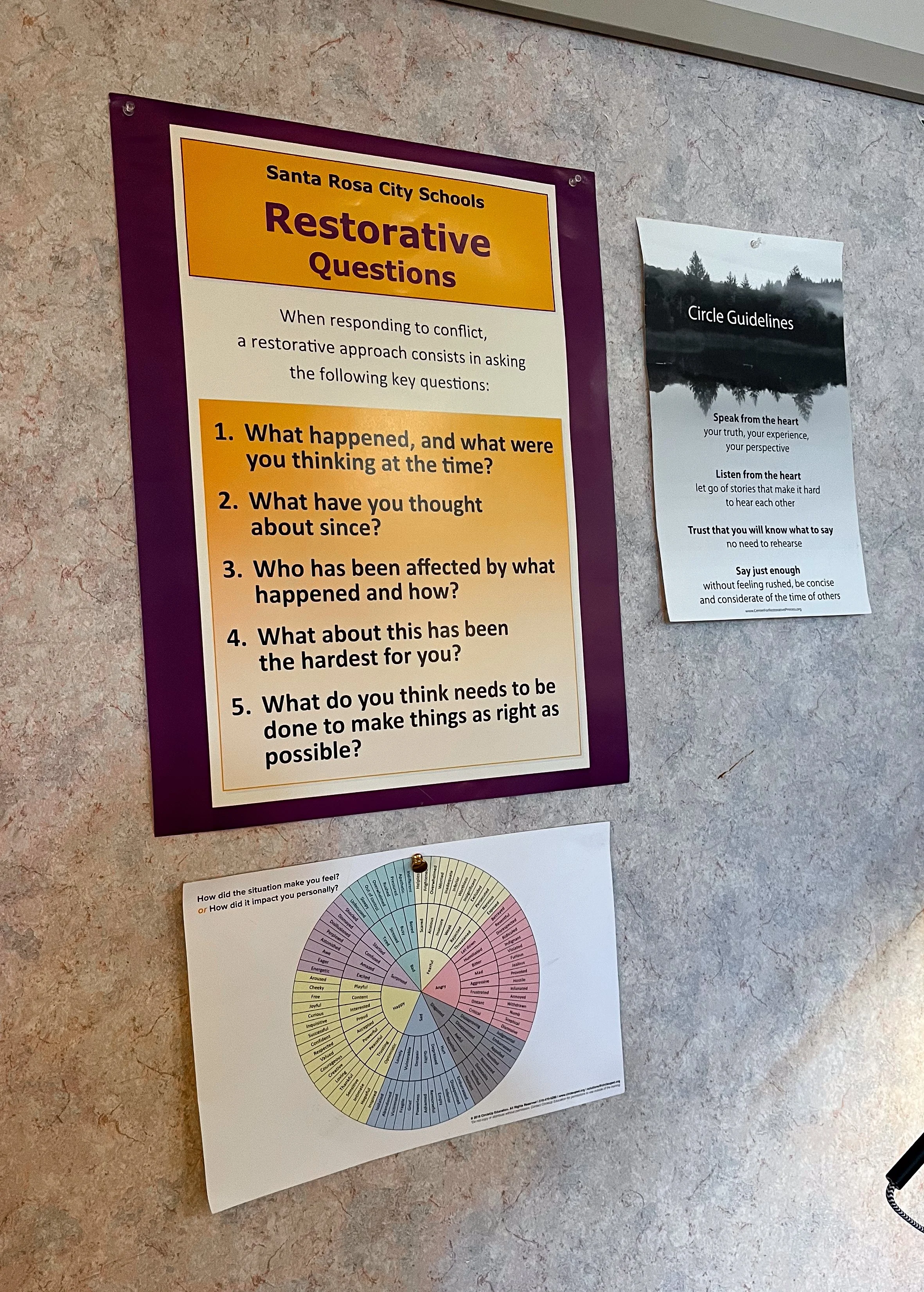Conflict without management; restorative facilities will be stripped from Carrillo
A poster asking “restorative questions” on the wall of the Carrillo restorative room ( Ruby Marie Costa-Thompson/The Puma Prensa)
By Ruby Marie Costa-Thompson, Features Editor
Fairness. Impartiality. Unprejudiced equality. The Lady of Justice represents the purest, most ideal version of justice, and it was Lorna McBade’s inspiration to become Maria Carrillo High School’s restorative specialist.
“I feel that my footprint on this earth is to try to keep those scales as even as possible,” McBade confides, though there is also a logistical side to her position. Before restorative specialists were introduced to Santa Rosa City Schools, there were many suspensions for things that the high schools no longer suspend for. These suspensions were due to poor conflict management. In the current day, students who get into a fight will work through the issue with McBade, but before restorative resources were brought to Carrillo, there wasn’t such a resource and the school decided on suspensions and harsher punishments instead. There was also, notably, an inequitable number of suspensions for people of color. The district knew something needed to be done about this, so instead of continuing to send students home, they brought in restorative specialists to help resolve the conflicts in the schools. “That was the impetus for this, and it was very unusual. A lot of schools don’t have what we have,” McBade declares proudly, seeing as restorative specialists are not a nationwide requirement.
Restorative specialists differ from counselors and therapists due to their priorities and training. Among other things, counselors deal with class selection and other academic matters at Carrillo, but McBade claims that's “not her forte.” Therapists focus on student mental health, but the job of a restorative specialist is to retain community wholeness.
Restorative justice is a crucial part of Carrillo’s community, and it has helped maintain peace at our school since its implementation. McBade explains the two principles of restorative: proactive and reactive. Proactivity is key, as it maintains connectivity before conflict happens. Classroom circles, making personal connections, and keeping relations are implemented to facilitate this peace. Reactivity is only needed if something does happen, and then McBade can work through the conflict in a healthy way.
First, McBade urges individuals to name what they were thinking at the moment of conflict – ”I was so angry,” or “I was so frustrated.” After they have had time to reflect, she asks what they think now. This is the “cerebral part,” as she calls it, where she simply needs to gather the straight facts and understand the situation. But then, she asks another question. “Who's been affected by this?” McBade claims this question broadens an individual's thought process from “it's just me and the other person” to “the teacher, my parent, the janitor,” and this causes the ripple of the conflict to get bigger and bigger. This is where students can truly understand their mistake and what can be done to fix it. Instead of immediate punishment, individuals are asked what they can do to move forward. This could include talking or writing letters to those involved, or whatever else the people in the conflict think is right. This transforms conflict management from a punitive procedure to an engaging process that prompts people, especially younger students, to consider their actions and their effects. Both students and staff use this resource, so it truly affects the entire Carrillo student body.
Because of this, the recent development around restorative in Carrillo is especially alarming. As of July, about 27 individuals with work related to restorative have been laid off definitively. The District claimed there was “no sense” in having a restorative program, as the wellness center could handle all its duties. Initially, the district planned to keep eight individuals at the district office and only send them to schools when conflict arose, but now even that plan has been scrapped.
The loss of restorative facilities at Santa Rosa City schools will devastate staff and students, as the connections and relationships that McBade has worked so hard to build will disappear. McBade believes that “the relationship piece is the essence of good conflict management,” so conflict will undoubtedly arise without a restorative presence to build relationships. Dysregulated students won't have a place to regulate, as the wellness center will lack the resources to support every student who needs help. The quality of services will likely diminish as well, because staff will have fewer regulatory resources if involved in a student-teacher or teacher-teacher conflict. Most importantly, there will be fewer adults trained to help students through conflict on campus, and Carrillo’s community will suffer from higher tensions and unresolved disputes.
Some crucial conflict management skills, such as circle fluency, will also be lost. Students must feel comfortable participating in circles to help them deal with conflict or simply prevent it. However, classroom circles with on-site restorative individuals will disappear.
McBade feels such a personal connection to her position as restorative specialist, and this change will undoubtedly affect her. She wants to be able to give voice and space to every student, but she cannot now. She truly believes in the fantastic things the youth can accomplish when given the space and respect. She is also amazed at how “wise and incredibly in tune” the youth can be, and allowing them to have a safe space gave her the chance to accomplish her goal of keeping the scales of justice as equal as possible. Knowing that she has had a “positive ripple” makes her feel incredibly accomplished and gives her a better experience in and outside school. McBade knows conflict is natural, and working through it healthily is astounding to her. “There's magic that happens.”
Above all else, McBade is concerned that this resource will disappear. Restorative culture has been integrated into Santa Rosa City schools for ten years, and most people will notice this missing piece on their campus when it’s gone. “Carrillo’s community won’t be the same.”

